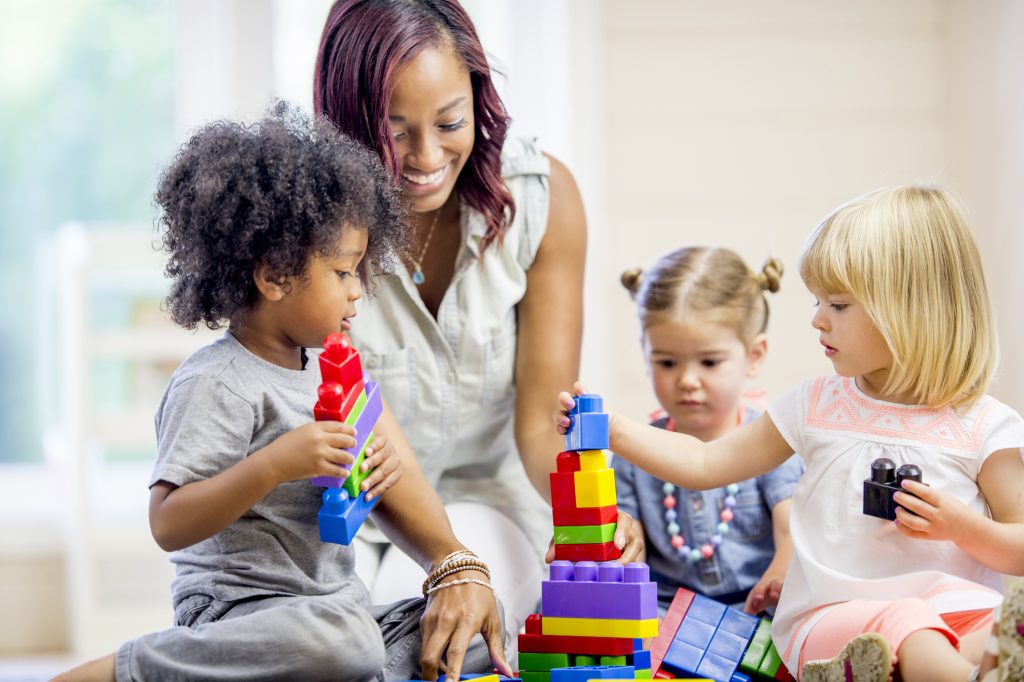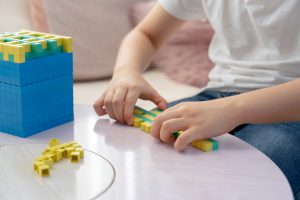Preschool teachers are expected to ensure that their students have a strong foundation in early math, including numbers and operations, sorting, measurement, patterns, shapes, and spatial relations. The goal is for children to build on these math skills in subsequent grades in school. But children are not always eager to engage in math activities. There are many reasons why children express total disinterest or even active resistance around math learning, and getting them involved can feel daunting.
This blog is for educators and caregivers of young children who have encountered resistance around math learning and wondered what to do about it.
Motivating All Children Around Math
The first question to ask yourself is: How engaging are your math classroom activities? Rote counting and worksheets (e.g., drawing a line from a picture of four apples to the number 4) can get some students engaged for some amount of time, especially if the worksheets are easy for the children. But they’re not nearly as enticing as playing with trucks or finger painting, and not very effective in developing math understanding. Of course, threats and bribes can get children to do things they don’t want to do in the short term, but they’re not effective strategies in the long run. Furthermore, they undermine the emotionally safe environment we know children need to thrive.
A better strategy is to create math learning activities that are fun and feel more like games. For example, have a conversation about math while children are doing activities they enjoy, such as playing with those enticing trucks or finger-painting sets. You can also make math activities more interesting by giving them a theme. For example, if you are counting bears, pretend the bears are in the forest and mama bear wants to make sure that all her babies are with her. Ask questions that promote math skills, such as: “If two bears get lost [covered up by your hand], how many bears are left?”
Here are some additional ideas of math activities that may feel more like games to students:
- “Let’s walk around the classroom and see how many circles we can find. Which is the biggest?”
- “Let’s measure our hands with these rulers. Whose hand comes to the 3? Does anyone have a hand that goes all the way to the 4? How about somewhere between 3 and 4?”
- “I’m thinking of a number between 13 and 15? What do you think it is?”
Activities that involve groups or pairs of children can be good for teaching both math and social skills. Here is an example of one such whole group activity:
- The teacher maps a 6’ x 10’ grid on a shower curtain, which she spreads on the floor. She asks the children to take off one shoe and sort all of the shoes into six piles—sandals, slip-ons, shoes with laces, etc. Then, in the bottom row of the grid, they place one shoe from each pile in its own square, followed by the rest of the shoes from that category, one each in the squares above the first shoe. After the children count the number of shoes in each column, the teacher talks with them about which columns are longer and shorter, and which categories have the most and the fewest shoes. “Are there any categories that have the same number of shoes? How many more sandals than slip-on shoes are there?”
For the children, this is a game; they do not know they are doing a math lesson. The teacher, however, planned the activity to help children develop particular math skills, including sorting, counting, graphing, and measurement. In addition to math, the children figure out the shoe classification system, collaborate in creating the columns of shoes, and learn to take turns to answer the teacher’s questions
This kind of playful math instruction requires a lot of planning. But, happily, teachers don’t need to rely entirely on their own creativity to develop activities that promote math learning. The DREME For Teachers website offers many activities and ideas for supporting math in the classroom. Playful math activities won’t guarantee all children’s enthusiastic engagement, but they help a lot.
Here are a few other suggestions for engaging children around math:
- Young children want autonomy, so offer choices rather than directives about how to do an activity: “Would you like to count paper clips or buttons? What color crayons do you want to count? What kind of pattern can you make with these blue and red squares?
- Show your own interest in the activity: “I played this when I was your age and loved it.”
- Provide a reason for why you want to do math: “Let’s count out how many raisins are in each bag so we make sure everyone has the same. How many raisins should everyone get, 5 or 10?”
Getting All Children Involved in Math Learning
What if there are still a few reluctant children? To figure out an effective strategy, we first need to understand the reason for the reluctance. Below are a few common reasons and some suggestions for how to respond.
They have other things they prefer to do.
- Having a predictable, regular time for math activities helps. Children get used to routines.
- Describing an activity as “really fun” can pique their interest.
- Sometimes it can help to give the reluctant child a role: “Henry, please give five chips to everyone at the table.”
- Get the activity started with other children. Sometimes the reluctant child will join in upon seeing their peers doing the activity.
- Call on a child who doesn’t seem interested in the activity: “Aurora, do you see any circles in the classroom?”
The activity is too easy and they get bored.
- Make it just a little more challenging: “You counted 11 bears, but a few more wandered out of the woods. How many there are now. Can you make a pattern with all four colors/shapes?”
They run into difficulty or aren’t sure of themselves.
Even young children can be reluctant to do something that they aren’t sure they can do correctly. Sometimes they are actively involved in a task until it becomes a bit more difficult.
- Reduce the difficulty level: “That’s a lot of bears to count. How about counting the dinosaurs in this bag [with fewer]?” Or, “Instead of pairing the cards with dots to the card with a numeral on it, try to put the cards with dots in order. First, the card with one dot, then the card with two dots. What comes next?”
- Make it a joint effort: “Let’s count the fish crackers in the bowl together.”
- Ask two children to work on the task together to take the pressure off the less secure child.
- Give some help: “Let’s count how many bears you had—1, 2, 3, 4. Here are the two we added. Count them all and see how many you have now.”
- If a child is struggling or comes up with a wrong answer, don’t tell them they are wrong. Ask them to try again: “Try counting the bears again and see if you get a different number.”
There are many different math activities and ways to engage children in math learning. Follow the child’s lead and be creative and flexible to make the most of math time together.



